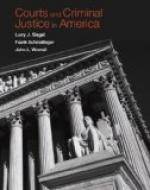“Ach, dose young men!” he exclaimed, wringing his hands—“Dose young men, dey come here and dey opened der vindow and let out der gas and all mine evidence esgaped.”
It is said that this interesting personage once instructed his jury to find that “the diseased came to his death from an ulster on the stomach.”
These anecdotes are, perhaps, what judges would call obiter dicta, yet the coroner’s court has more than once been utilized as a field in the actual preparation of a criminal case. When Roland B. Molineux was first suspected of having caused the death of Mrs. Adams by sending the famous poisoned package of patent medicine to Harry Cornish through the mails, the assistant district attorney summoned him as a witness to the coroner’s court and attempted to get from him in this way a statement which Molineux would otherwise have refused to make.
When all the first hullabaloo is over and the accused is under arrest and safely locked up, it is usually found that the police have merely run down the obvious witnesses and made a prima facie case. All the finer work remains to be done either by the district attorney himself or by the detective bureau working under his immediate direction or in harmony with him. Little order has been observed in the securing of evidence. Every one is a fish who runs into the net of the police, and all is grist that comes to their mill. The district attorney sends for the officers who have worked upon the case and for the captain or inspector who has directed their efforts, takes all the papers and tabulates all their information. His practiced eye shows him at once that a large part is valueless, much is contradictory, and all needs careful elaboration. A winnowing process occurs then and there; and the officers probably receive a “special detail” from headquarters and thereafter take their orders from the prosecutor himself. The detective bureau is called in and arrangements made for the running down of particular clues. Then he will take off his coat, clear his desk, and get down to work.
Of course, his first step is to get all the information he can as to the actual facts surrounding the crime itself. He immediately subpoenas all the witnesses, whether previously interrogated by the police or not, who know anything about the matter, and subjects them to a rigorous cross-examination. Then he sends for the police themselves and cross-examines them. If it appears that any witnesses have disappeared he instructs his detectives how and where to look for them. Often this becomes in the end the most important element in the preparation for the trial. Thus in the Nan Patterson case the search for and ultimate discovery of Mr. and Mrs. Morgan Smith (the sister and brother-in-law of the accused) was one of its most dramatic features. After they had been found it was necessary to indict and then to extradite them in order to secure their presence within the jurisdiction, and when all this had been accomplished it proved practically valueless.




